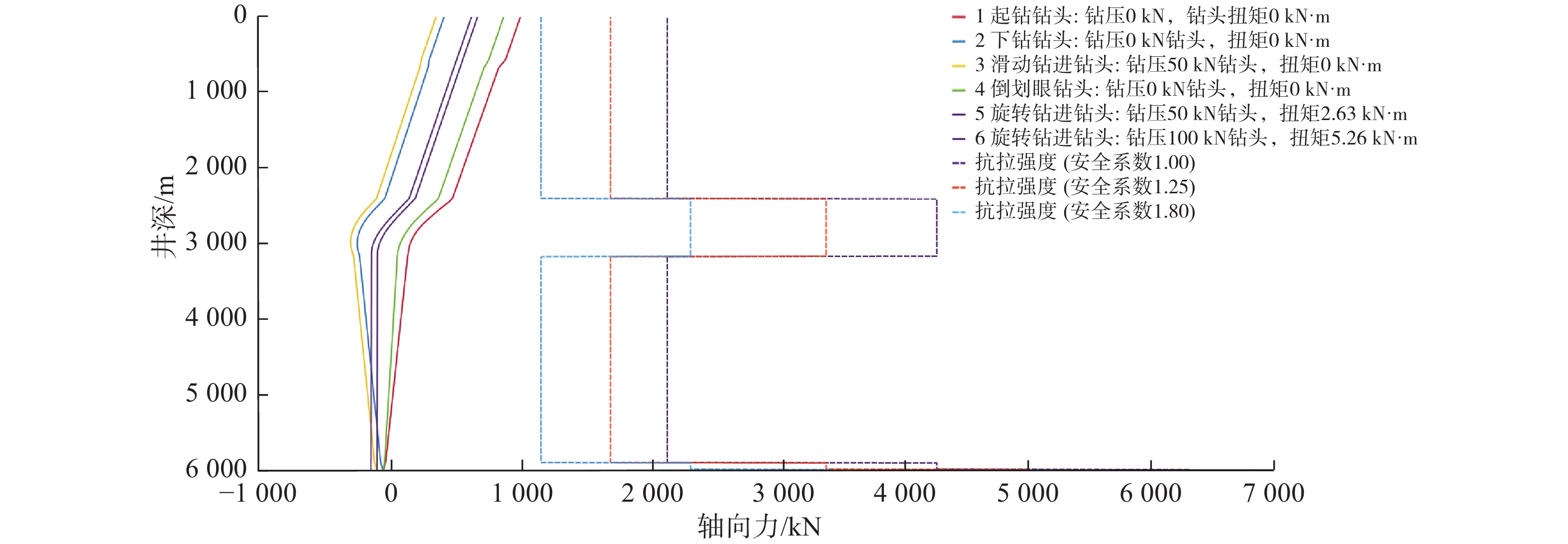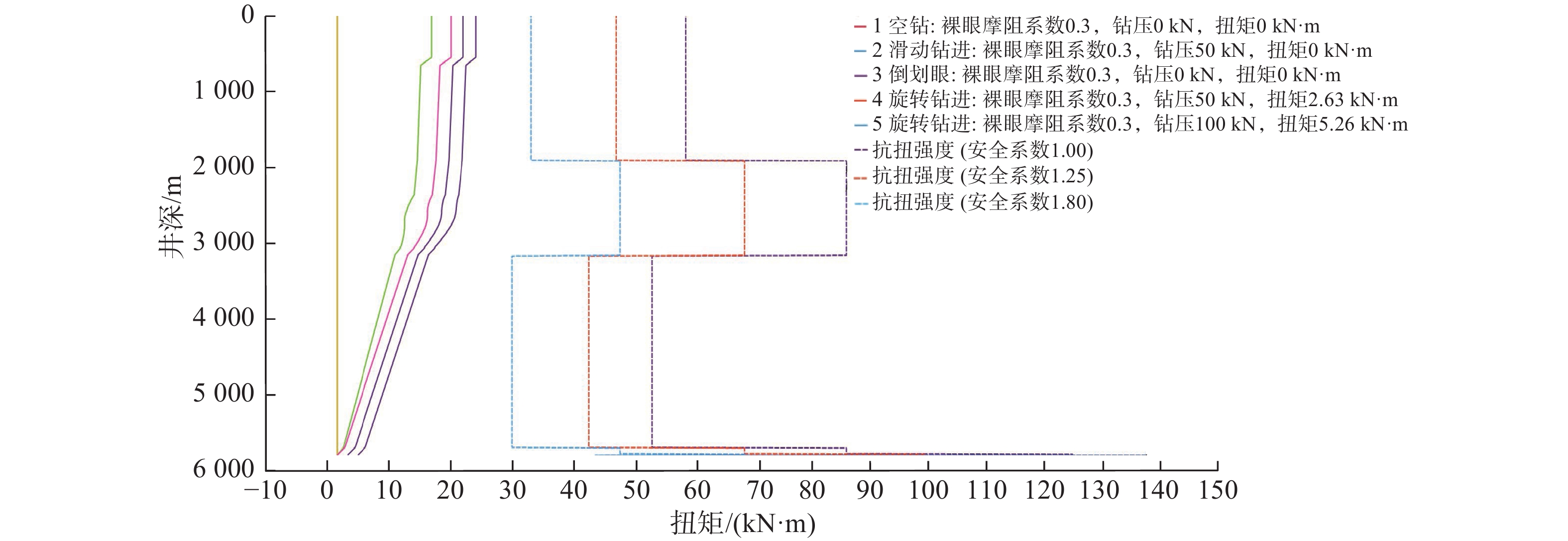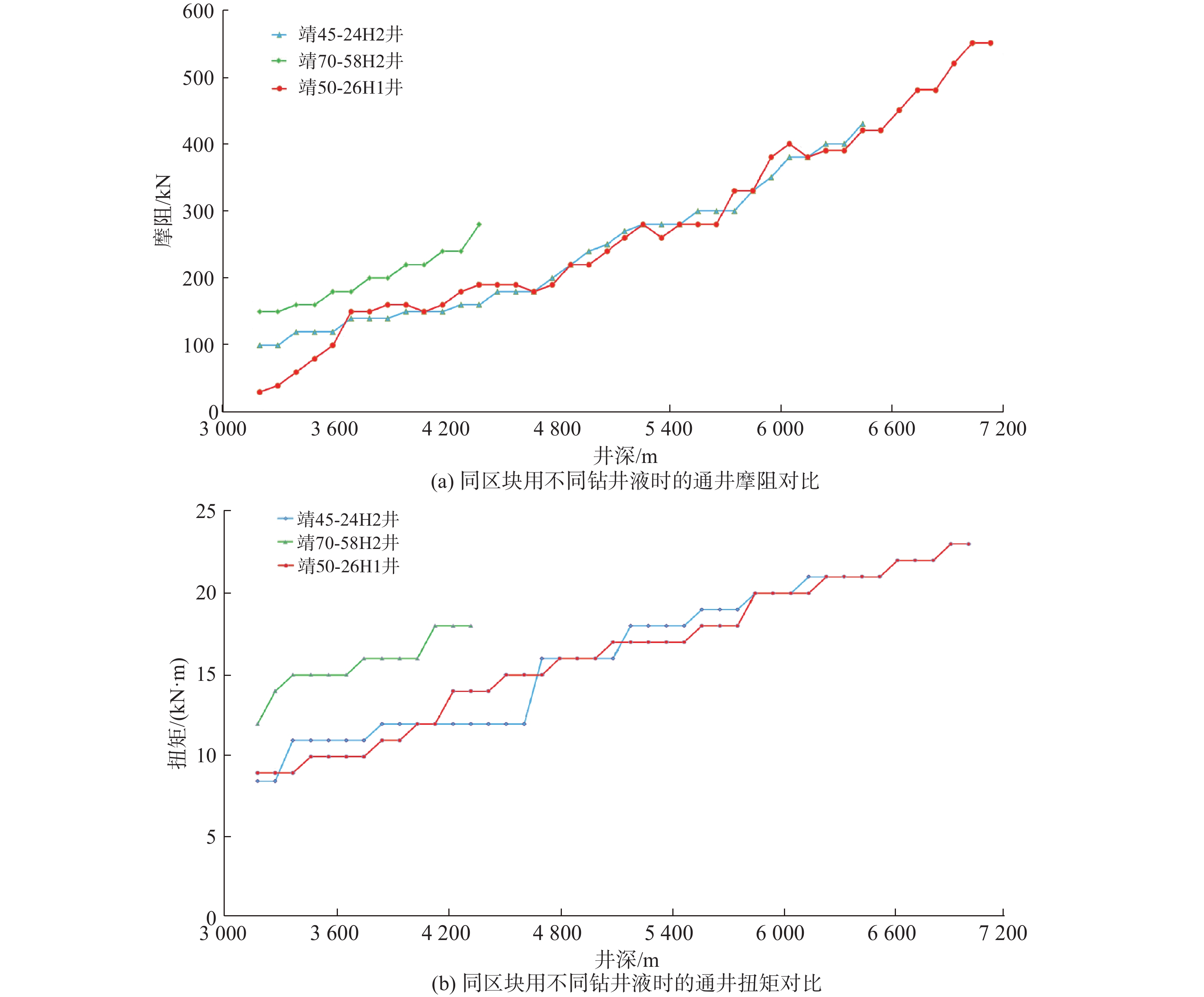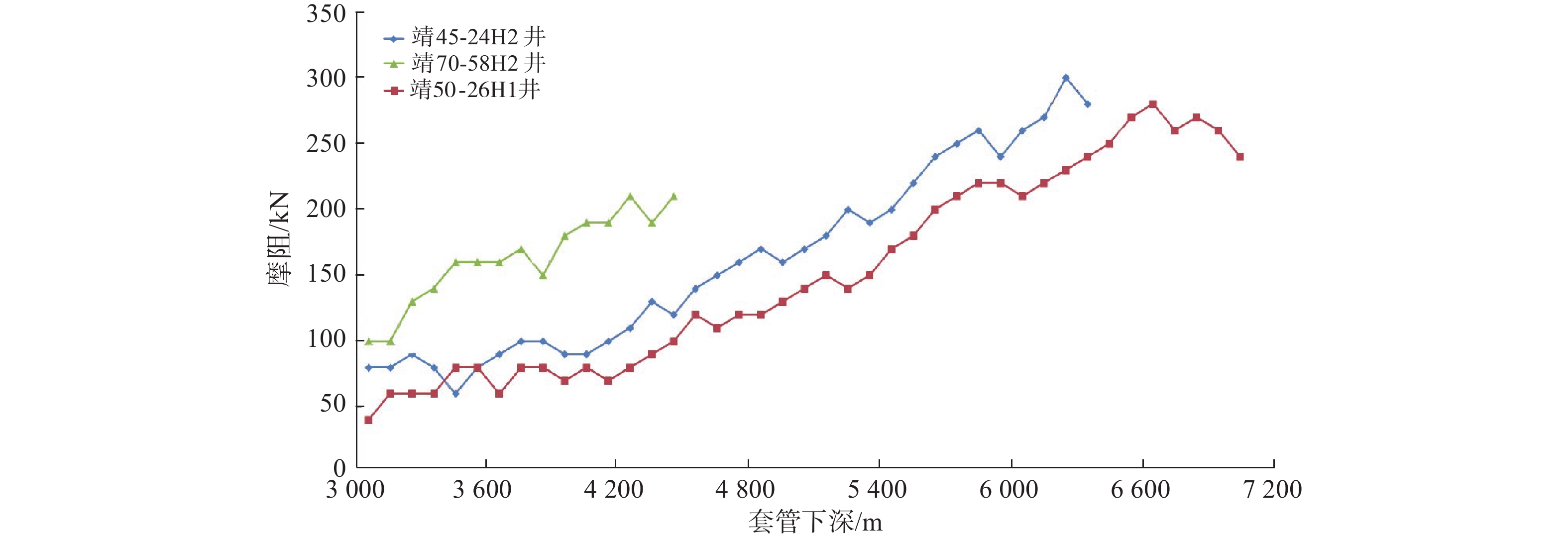Key Technologies for Drilling and Completing Horizontal Wells with Ultra-Long Horizontal Sections in the Sulige Tight Gas Reservoirs
-
摘要: 针对苏里格气田致密气藏超长水平段水平井钻井完井过程中循环泵压高、摩阻扭矩大、机械钻速低、井眼清洁困难、完井套管柱下入困难等问题,分析了超长水平段水平井钻井完井技术难点,进行了高效钻具和钻井设备优化配置、井眼轨道设计和井眼轨迹控制、水平段钻井提速和清洁,以及旋转导向钻井、强抑制润滑性水基钻井液和“旋转引鞋+套管”漂浮下入等技术研究,形成了苏里格致密气藏超长水平段水平井钻井完井关键技术。现场试验2口井,平均井深7 027 m,平均水平段长3 719.5 m,钻井周期50.93 d,取得了很好的效果。其中,靖50-26H1井完钻井深7 388 m,水平段长4 118 m,创造了当时长庆油田井深最深和国内陆上油气井水平段最长2项纪录。研究与试验结果表明,该技术可为苏里格致密气藏高效勘探开发提供技术支撑,也可为国内致密气超长水平段水平井安全高效钻井完井提供借鉴。Abstract: The drilling and completion of horizontal wells with ultra-long horizontal sections in the tight gas reservoirs of Sulige Gas Field is subject to problems such as high circulating pump pressure, large friction torque, low rates of penetration (ROP), difficult borehole cleaning, and difficulties in running the completion casing string. In response, the technical difficulties in the drilling and completion of such wells were analyzed. Research was conducted on technologies such as optimized allocation of high-efficiency drilling tools and equipments, borehole trajectory design and control, horizontal section drilling acceleration and cleaning, rotary steering system (RSS) drilling, strong inhibition and lubrication water-base drilling fluid, and “rotary guide shoe + casing” floating running, etc. The key technologies for drilling and completing horizontal wells with ultra-long horizontal sections in the Sulige tight gas reservoirs were developed and applied in 2 wells with an average well depth of 7 027 m and an average horizontal section length of 3 719.5 m. The drilling cycle was 50.93 d, which meant that the proposed technologies achieved a favorable effect. Between the two wells, the Well Jing50-26H1, with a total depth (TD) of 7 388 m and a horizontal section length of 4 118 m, established the records as the deepest well in Changqing Oilfield and the longest horizontal section of onshore oil and gas wells in China at that time. The research and application show that the key technologies can provide technical support for the efficient exploration and development of the Sulige tight gas reservoirs and a reference for safe and efficient drilling and completion of horizontal wells with ultra-long horizontal sections in tight gas fields in China.
-
-
表 1 典型的“导管+三开”井身结构
Table 1 Typical “conductor + three sections” casing program
开钻
次序钻头外径/
mm井深/
m套管外径/
mm套管下入
层位套管下入
深度/m水泥浆
返高备注 导管 444.5 50 426.0 第四系 50 地面 封流沙层、疏松易漏黄土层,确保表层施工安全 一开 346.1 500 273.1 直罗组 500 地面 封固上部易垮塌层、水层及漏层,进入稳定地层30 m
且井深不小于500 m,以满足井控要求二开 222.2 3 298 177.8 石盒子组 3 295 地面 封固复杂地层,为储层专打作好井筒准备 三开 152.4 6 298 114.3 石盒子组 0~6 295 技术套管
之上水泥返至技术套管800 m以上,满足采气要求 表 2 ϕ152.4 mm井眼中钻具在定排量下的循环压耗
Table 2 Circulating pressure losses of drilling tools in a ϕ152.4 mm borehole under fixed flow rate
钻头外径/
mm钻杆外径/
mm排量/
(L∙s–1)钻具内压耗/
MPa环空压耗/
MPa“钻头+螺杆+地面管汇”的
压耗/MPa循环泵压/
MPa环空返速/
(m∙s−1)152.4 88.9 18 34.04 5.39 7.1 46.54 1.49 101.6 13.81 9.35 7.1 30.26 1.78 注:钻井液密度1.33 kg/L,漏斗黏度70 s,塑性黏度21 mPa∙s,旋转黏度计ϕ600读数为66、ϕ300读数为45;水平段长4 000 m,井深7 300 m。 表 3 不同扣型钻具性能参数
Table 3 Parameters of drilling tools with different connection types
钻具
扣型钻杆
外径/mm钻杆接箍
尺寸/mm钻杆壁厚/
mm接头拉伸
载荷/kN接头扭矩
载荷/(kN∙m)管体拉伸
载荷/(kN∙m)管体扭矩
载荷/(kN∙m)内压强度/
MPa挤毁强度/
MPaCQST39 101.6 123.8 8.38 3 490 53.28 2 287 56.81 134.4 138.8 CQ40 3 300 33.30 2 300 56.80 134.4 138.8 表 4 膨胀降滤失水泥浆的性能
Table 4 Properties of expanded fluid loss reducing cement slurry
水泥浆 密度/
(kg∙L–1)API滤失量/
mL抗压强度1)/MPa 初始稠度/
Bc最终稠度/
Bc稠化时间2)/
min水泥石膨胀
率,%55 ℃/24 h 55 ℃/48 h 领浆 1.88~1.92 36 21.0 24.5 12 70 415 0.1 中浆 25.0 30.0 364 尾浆 27.0 32.5 314 注:1)抗压强度的测试条件,55 ℃/24 h指在55 ℃温度下老化24 h,55 ℃/48 h指在55 ℃温度下老化48 h;2)稠化条件为85 ℃/40 MPa。 表 5 试验井的技术指标
Table 5 Technical indicators of test wells
井号 完钻井深/m 水平段长/m 钻井周期/d 完井周期/d 建井周期/d 机械钻速/(m·h–1) 靖45-24H2 6 666 3 321 44.44 10.02 56.04 14.81 靖50-26H1 7 388 4 118 57.42 7.79 65.21 11.62 表 6 井眼轨道优化设计数据
Table 6 Data of optimized borehole trajectory design
剖面 造斜点井深/m 偏移距/m 入窗点井深/m 全角变化率/((°)·(30m)–1) 摩阻/kN 纠偏井段 扭方位井段 斜井段 优化前 1 000 600 3 200 0 4 12 42.3 优化后 650 600 3 200 3 6 5 27.3 注:优化前剖面,指“直—增—稳—降斜扭方位—稳—增—水平段”;优化后剖面,指“直—增—稳—增斜扭方位—稳—增—水平段”。 表 7 常规钻具与旋转导向钻具应用数据对比
Table 7 Application data comparison of conventional drilling tools and RSS drilling tools
井号 钻具组合 应用井段/m 全角变化率/
((°)·(30m)–1)最大 平均 靖45-24H2 PDC钻头+螺杆
钻具+ MWD+
水力振荡器3 345~5 107 3.87 1.77 靖50-26H1 3 270~5 132 3.48 1.98 靖45-24H2 旋转导向 5 107~6 666 2.56 0.59 靖50-26H1 5 132~7 388 3.06 0.89 -
[1] 史配铭,薛让平,王学枫,等. 苏里格气田致密气藏水平井优快钻井技术[J]. 石油钻探技术,2020,48(5):27–33. doi: 10.11911/syztjs.2020083 SHI Peiming, XUE Rangping, WANG Xuefeng, et al. Optimized fast drilling technology for horizontal wells in the tight gas reservoirs in Sulige Gas Field[J]. Petroleum Drilling Techniques, 2020, 48(5): 27–33. doi: 10.11911/syztjs.2020083
[2] 韩来聚,牛洪波,窦玉玲. 胜利低渗油田长水平段水平井钻井关键技术[J]. 石油钻探技术,2012,40(3):7–12. doi: 10.3969/j.issn.1001-0890.2012.03.002 HAN Laiju, NIU Hongbo, DOU Yuling. Key drilling technologies for long displacement horizontal wells of low permeability reservoirs in Shengli Oilfield[J]. Petroleum Drilling Techniques, 2012, 40(3): 7–12. doi: 10.3969/j.issn.1001-0890.2012.03.002
[3] 史配铭,肖春学,王建军. 苏里格南部气田大斜度井钻井技术[J]. 石油钻采工艺,2019,41(1):18–22. SHI Peiming, XIAO Chunxue, WANG Jianjun. Drilling technologies used for the highly deviated wells in Southern Sulige Gasfield[J]. Oil Drilling & Production Technology, 2019, 41(1): 18–22.
[4] 聂云飞,朱渊,范萧,等. 自激式涡流控制水力振荡器研制与应用[J]. 石油钻探技术,2019,47(5):74–79. NIE Yunfei, ZHU Yuan, FAN Xiao, et al. Development and application of self-excited vortex control hydraulic oscillator[J]. Petroleum Drilling Techniques, 2019, 47(5): 74–79.
[5] 李斐,魏来,郝英状,等. 岩屑床清除工具螺旋槽道优化设计[J]. 天然气与石油,2020,38(3):50–56. doi: 10.3969/j.issn.1006-5539.2020.03.010 LI Fei, WEI Lai, HAO Yingzhuang, et al. Optimization of spiral channel design of cleaning tools for cuttings bed[J]. Natural Gas and Oil, 2020, 38(3): 50–56. doi: 10.3969/j.issn.1006-5539.2020.03.010
[6] 王建龙,齐昌利,柳鹤,等. 沧东凹陷致密油气藏水平井钻井关键技术[J]. 石油钻探技术,2019,47(5):11–16. WANG Jianlong, QI Changli, LIU He, et al. Key technologies for drilling horizontal wells in tight oil and gas reservoirs in the Cangdong Sag[J]. Petroleum Drilling Techniques, 2019, 47(5): 11–16.
[7] 高爱庭. 玛湖油田致密砂砾岩油藏钻井提速研究[J]. 江汉石油职工大学学报,2019,32(6):22–24. GAO Aiting. A study on drilling acceleration in tight sand conglomerate reservoir in Mahu Oilfield[J]. Journal of Jianghan Petroleum University of Staff and Workers, 2019, 32(6): 22–24.
[8] 耿立勇,苑塔亮. 旋转导向钻井技术在HD10-1-H2井的应用[J]. 江汉石油职工大学学报,2020,33(1):55–57,86. doi: 10.3969/j.issn.1009-301X.2020.01.017 GENG Liyong, YUAN Taliang. Application test of rotary steering drilling technology in HD10-1-H2 Well[J]. Journal of Jianghan Petroleum University of Staff and Workers, 2020, 33(1): 55–57,86. doi: 10.3969/j.issn.1009-301X.2020.01.017
[9] 路保平,倪卫宁. 高精度随钻成像测井关键技术[J]. 石油钻探技术,2019,47(3):148–155. doi: 10.11911/syztjs.2019060 LU Baoping, NI Weining. The key technologies of high precision imaging logging while drilling[J]. Petroleum Drilling Techniques, 2019, 47(3): 148–155. doi: 10.11911/syztjs.2019060
[10] 路宗羽,赵飞,雷鸣,等. 新疆玛湖油田砂砾岩致密油水平井钻井关键技术[J]. 石油钻探技术,2019,47(2):9–14. doi: 10.11911/syztjs.2019029 LU Zongyu, ZHAO Fei, LEI Ming, et al. Key technologies for drilling horizontal wells in glutenite tight oil reservoirs in the Mahu Oilfield of Xinjiang[J]. Petroleum Drilling Techniques, 2019, 47(2): 9–14. doi: 10.11911/syztjs.2019029
[11] 柳伟荣,倪华峰,王学枫,等. 长庆油田陇东地区页岩油超长水平段水平井钻井技术[J]. 石油钻探技术,2020,48(1):9–14. doi: 10.11911/syztjs.2020029 LIU Weirong, NI Huafeng, WANG Xuefeng, et al. Shale oil horizontal drilling technology with super-long horizontal laterals in the Longdong Region of the Changqing Oilfield[J]. Petroleum Drilling Techniques, 2020, 48(1): 9–14. doi: 10.11911/syztjs.2020029
[12] 胡祖彪,张建卿,王清臣,等. 长庆油田华H50-7井超长水平段钻井液技术[J]. 石油钻探技术,2020,48(4):28–36. doi: 10.11911/syztjs.2020050 HU Zubiao, ZHANG Jianqing, WANG Qingchen, et al. Drilling fluid technology for ultra-long horizontal section of Well Hua H50-7 in the Changqing Oilfield[J]. Petroleum Drilling Techniques, 2020, 48(4): 28–36. doi: 10.11911/syztjs.2020050
[13] 朱宝忠. 国内页岩气长水平井JY2-5HF井钻井液技术[J]. 钻井液与完井液,2018,35(6):60–64. doi: 10.3969/j.issn.1001-5620.2018.06.011 ZHU Baozhong. Drilling fluid technology for long horizontal shale gas Well JY2-5HF in China[J]. Drilling Fluid & Completion Fluid, 2018, 35(6): 60–64. doi: 10.3969/j.issn.1001-5620.2018.06.011
[14] 张明昌,张新亮,高剑玮. 新型XPJQ系列下套管漂浮减阻器的研制与试验[J]. 石油钻探技术,2014,42(5):114–118. ZHANG Mingchang, ZHANG Xinliang, GAO Jianwei. Developing and testing XPJQ series floating friction reducers for running casing[J]. Petroleum Drilling Techniques, 2014, 42(5): 114–118.
[15] 邹书强,张红卫,伊尔齐木,等. 顺北一区超深井窄间隙小尾管固井技术研究[J]. 石油钻探技术,2019,47(6):60–66. doi: 10.11911/syztjs.2019114 ZOU Shuqiang, ZHANG Hongwei, Eerqm, et al. Slim liner cementing technology for ultra-deep wells with a narrow annulus in No. 1 district of Shunbei Block[J]. Petroleum Drilling Techniques, 2019, 47(6): 60–66. doi: 10.11911/syztjs.2019114
-
期刊类型引用(23)
1. 车继勇,丁鹏,王红月,马永刚. 组合钻具定向钻井造斜及提速技术方法. 设备管理与维修. 2024(08): 98-100 .  百度学术
百度学术
2. 熊浪豪,巢世伟,柏尚宇,陈君,范乘浪,崔建峰. E Zhanbyrshy-3井钻井实践及技术难点分析. 内蒙古石油化工. 2023(05): 63-66+120 .  百度学术
百度学术
3. 汪伟,柳贡慧,李军,查春青,连威,夏铭莉. 脉动式扭转冲击钻井工具工作特性分析与测试. 石油钻探技术. 2022(05): 63-69 .  本站查看
本站查看
4. 宋周成,翟文宝,邓昌松,徐杨,徐席明,汪鑫,文涛. 富满油田超深井井身结构优化技术与应用. 钻采工艺. 2022(06): 36-41 .  百度学术
百度学术
5. 王涛,刘锋报,罗威,晏智航,陆海瑛,郭斌. 塔里木油田防漏堵漏技术进展与发展建议. 石油钻探技术. 2021(01): 28-33 .  本站查看
本站查看
6. 崔月明,史海民,张清. 吉林油田致密油水平井优快钻井完井技术. 石油钻探技术. 2021(02): 9-13 .  本站查看
本站查看
7. 苏崭,王博,盖京明,李玮,赵欢,陈冰邓. 复合式扭力冲击器在坚硬地层中的应用. 中国煤炭地质. 2021(05): 47-50+57 .  百度学术
百度学术
8. 张强,饶志华,秦世利,金勇. 南海东部深层古近系高效开发技术探索与实践. 石油化工应用. 2021(06): 34-38 .  百度学术
百度学术
9. 李银婷,董小虎. 顺北油田钻井参数强化的提速效果评价. 钻探工程. 2021(07): 72-78 .  百度学术
百度学术
10. 陈冬毅,徐鲲,张作伟,吕广,张鑫,郭小明. 恒压恒扭工具在渤海油田中的应用. 科学技术创新. 2021(22): 153-154 .  百度学术
百度学术
11. 严德,张玉山,宋玲安,陈彬,李彬,刘保波. 深水高温高压井钻井技术探索与实践. 中国石油和化工标准与质量. 2021(13): 193-194 .  百度学术
百度学术
12. 张喆,闫楚旋,冯震,脱直霖,石朝龙. 塔里木油田HLHT区块优快钻井技术研究. 云南化工. 2021(10): 127-129 .  百度学术
百度学术
13. 李双贵,于洋,樊艳芳,曾德智. 顺北油气田超深井井身结构优化设计. 石油钻探技术. 2020(02): 6-11 .  本站查看
本站查看
14. 袁国栋,王鸿远,陈宗琦,母亚军,席宝滨. 塔里木盆地满深1井超深井钻井关键技术. 石油钻探技术. 2020(04): 21-27 .  本站查看
本站查看
15. 张智亮,王威,伊明,刘强. 井下安全监控系统设计与实现. 石油钻探技术. 2020(06): 65-70 .  本站查看
本站查看
16. 周波,汪海阁,张富成,纪国栋,韩泽龙,武强. 温度压力对岩石可钻性和破岩效率影响实验. 石油钻采工艺. 2020(05): 547-552 .  百度学术
百度学术
17. 李林涛,万小勇,黄传艳,潘丽娟,郭知龙,曹宗波,张伟博. 双向卡瓦可回收高温高压封隔器的研制与应用. 石油机械. 2019(03): 81-86 .  百度学术
百度学术
18. 路宗羽,赵飞,雷鸣,邹灵战,石建刚,卓鲁斌. 新疆玛湖油田砂砾岩致密油水平井钻井关键技术. 石油钻探技术. 2019(02): 9-14 .  本站查看
本站查看
19. 江波,任茂,王希勇. 彭州气田PZ115井钻井提速配套技术. 探矿工程(岩土钻掘工程). 2019(08): 73-78 .  百度学术
百度学术
20. 郑振国,黎红胜,赵海艳,温慧芸,孙东方. 哥伦比亚Matambo区块深井钻井关键技术. 石油钻探技术. 2018(02): 30-37 .  本站查看
本站查看
21. 丁红,宋朝晖,袁鑫伟,邢战,张宏阜,张仪. 哈拉哈塘超深定向井钻井技术. 石油钻探技术. 2018(04): 30-35 .  本站查看
本站查看
22. 李世昌,闫立鹏,李建冰,白文路,杨秀丽,闫天宇. 自循环粒子射流钻井提速工具机理研究. 中国锰业. 2018(03): 98-102 .  百度学术
百度学术
23. 陈养龙,席宝滨,晁文学,朱伟厚. 顺北区块Ⅰ号断裂带钻井分层提速技术. 断块油气田. 2018(05): 649-652 .  百度学术
百度学术
其他类型引用(7)




 下载:
下载:









